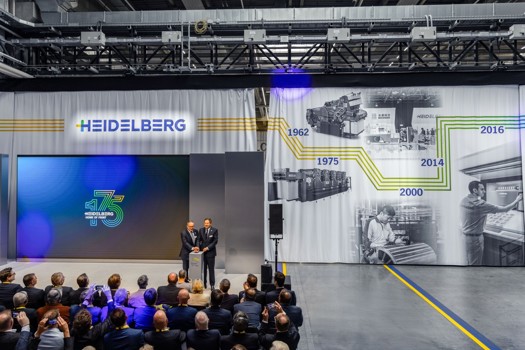Click here to return to the Technology report contents page
You may find the compare the meerkat/compare the market adverts simple minded rather than simples, and you'd probably rather direct the opera singer asking you to go compare to go somewhere else, but there's no escaping the rise of online price comparison websites.
While there's no directly equivalent online price comparison platform for print, there's no doubt that we all expect more or less instant pricing for anything these days, whether it's via the internet or more traditional means. It wasn't always that way in print.
"In years gone by printers could almost dictate to their clients when they could expect to get their quotes back," says MIS supplier Tharstern's executive director Abdul Kassas. But this is no longer acceptable.
"Typically, printers turn quotes around in four hours, and there is a correlation between time to turn a quote around and winning the work," says Shuttleworth joint managing director Paul Deane.
Speed counts
If four hours is the norm, and speed of turning around the quote has an impact on whether you win the work or not, you can bet there's a huge demand for quicker quotes than that.
"We're constantly being told that estimating is where printers are focusing their attentions," says Jonathan Richards, chairman of MIS supplier Imprint. "If you're too slow getting back, the work will be placed elsewhere, if you're too expensive you won't get the work and if you come out with a figure that is too cheap, you've lost money."
Using the standard estimating tools in a typical MIS takes time and requires a skilled estimator who knows what they're doing. Kassas says that the average time to turn an estimate around is 15-20 minutes. He also adds that when it comes to keeping the presses filled, "quoting is a numbers game, the more quotes you produce, the more work you'll win."
And it's a game with the odds stacked against the printer at the moment, according to Deane: "Printers have to do a lot more quotes to get the same amount of work."
Without new technology or techniques, the only way to turn around more quotes more quickly is to throw people and, through a higher wage bill, money at the problem. In these days of tight margins, adding cost, especially in non-production roles, is not a desirable option, especially when, as run lengths come down, the value of the job to absorb those administration costs is itself coming down, while raw materials prices such as paper are rising.
Route of the problem
So what are the answers? One is what's called route-based estimating, which first came to prominence a couple of years ago through the efforts of firms such as Brightblue and Haybrooke Consultants. If you trawl the patent applications using the term "route-based estimating", you're likely to stumble across some technology used in price comparison sites (see box).
Imprint has also had what it calls expert estimating for some time, and other MIS vendors are starting to get on board too, with Tharstern showing route-based estimating for the first time at Ipex.
However, Kassas acknowledges the method is not perfect for 100% of jobs. Eclipse Colour Print in Kettering is a Tharstern customer, but it also uses Haybrooke's PDQ system for route-based estimating. Eclipse commercial manager Warren Drew says: "PDQ is all about how well you set it up, at 95% infallible it's way better than an estimator." However he also cautions that it can't model some of the company's more complex work yet.
Other options
The route-based option isn't the only way to speed up estimating. Shuttleworth has taken a different approach with its Supply Chain Manager and Estimating Wizard.
"If all factors of price are under the printer's control, then estimating is relatively easy," says Deane. "But if they have to get quotes for outwork then that can influence turnaround times.
"That is why we developed Supply Chain Manager. Customers using Estimating Wizard report a 30% increase in speed. It also takes some of the technical aspects out, so you don't need to use such a skilled estimator.
"You want to minimise overheads not related to production. One way is to have multi-functional people, so you can have account managers being able to estimate too."
Taking out time and cost is all very well, but with an increasingly web-savvy generation of buyers, what about providing them with an online platform? Well, there is some debate about the value in offering instant online quoting.
"Why would a printer want to do that?" asks Deane. "And why would the customer? For the customer, it is easier to just send an email to all its printers and compare on that basis."
However, not everyone agrees. Eclipse is in the process of developing an online self-service estimating tool.
"Customers want their prices immediately and have said that an online quoting tool would be great for them," says Eclipse's Drew.
An online platform has also been the recent focus of Imprint, which concurs that the move has been prompted by requests from customers. At Ipex, it will launch an online version of its Expert estimating system that can be used by printers' customers for self-service quotes.
"At least 10% of our estimates are what I'd call variations on a theme," says Drew. "And for those sort of ‘what-if' scenarios, route-based estimating is much quicker."
One of the big advantages is that it allows the customer to do a lot of ‘what-if' estimates to compare how different stocks, colours and paginations will influence the price before they start designing a job.
Quote quandary
One of the worries about putting your estimating online and into the hands of clients is that you could yourself just become an online pricing benchmark without actually winning any work on the back of it, but there's nothing to say that clients aren't already using you to quote for exactly the same reason. At least if they're doing it themselves online, your estimators aren't tied up quoting for a job you were never going to get.
Drew's answer is simple: although Eclipse plans to put its system online, only customers who have a log-in can carry out online estimates.
Imprint's Richards says there are a number of options to ensure you remain in control, even if the estimating tool is open access.
"You can configure the system so that it displays the quote online immediately, or you can set it up to send an email later with the estimate," he says. "That way you can add a check stage, so the sales director can vet estimates and keep control."
In that scenario, you might find that someone who initially came to your site to benchmark other printers' prices, might ends up as a customer. So, while price comparison websites may seem a leap too far for some, the prospect of harvesting more clients in tough economic times cannot be ignored.
HOW IT WORKS: ROUTE-BASED ESTIMATING
Route-based estimating relies on the ability of a computer to process thousands of different permutations available to determine the lowest cost result. For example, in a car insurance price comparison website, this would involve taking your details – address, age, driving history, type of car, profession and so on – and then running those details through multiple insurance companies’ own risk-calculation software to come up with a range of prices.
With different firms using slightly different methods and assumptions to calculate your risk, you then get a spread of prices. In the case of print manufacturing, you enter the details about the production capabilities of every bit of equipment in your factory, their running speeds and hourly rates and the customer picks from drop down menus for format, stock, pagination, colours and binding style to produce the results.
One advantage of this approach is it’s possible to compare how different production techniques compare for example digital versus litho and sheetfed versus web, which can throw up some surprises.
There’s a realisation that an expert estimating system can beat a human estimator, says Jonathan Richards, chairman of MIS supplier Imprint. Both myself and other Imprint staff who were estimators have been surprised by some of the decisions the system has made, especially when it’s come out with a cost lower than we did.
And you can see the working of the system to make sure you can see how it has achieved the better results.
Working that way, it’s possible for an estimator to learn new tricks from the estimating system.
Click here to return to the Technology report contents page










